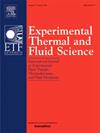Study on the stability of low heat release rate flames by laser-induced breakdown spectroscopy
IF 2.8
2区 工程技术
Q2 ENGINEERING, MECHANICAL
Experimental Thermal and Fluid Science
Pub Date : 2024-12-06
DOI:10.1016/j.expthermflusci.2024.111386
引用次数: 0
Abstract
This study investigated the effects of burner rim thickness on the stabilization characteristics of non-premixed jet flames with low heat release rate (HRR), which is crucial for expanding the application of low HRR fuels (e.g., ammonia) in practical burners. HRR of a flame is a significant parameter since flame stability is influenced by the balance of HRR and heat loss rate. In this study, low HRR fuels were simulated by CH4-N2 mixtures and their flames were formed above a quadruple-slot burner with different rim thicknesses. OH* chemiluminescence imaging showed that flames with low CH4 content in fuel lifted off and stabilized by triple flame structures above the thinner rim; thicker rim prevented flame liftoff but reduced the reaction intensity at flame bases. Mole fraction distributions of CH4, O2 and N2 in the vicinity of the rims were measured by laser-induced breakdown spectroscopy (LIBS), and the appropriate choice of nitrogen spectral lines was discussed. LIBS results indicated that fuel–air mixing was more effective near the thicker rim. However, species diffusion at the flame bases above the thinner rim was faster, resulting in higher reaction intensity. The results suggest that the flame stabilization mechanism above thinner rims and thicker rims may be different.
求助全文
约1分钟内获得全文
求助全文
来源期刊

Experimental Thermal and Fluid Science
工程技术-工程:机械
CiteScore
6.70
自引率
3.10%
发文量
159
审稿时长
34 days
期刊介绍:
Experimental Thermal and Fluid Science provides a forum for research emphasizing experimental work that enhances fundamental understanding of heat transfer, thermodynamics, and fluid mechanics. In addition to the principal areas of research, the journal covers research results in related fields, including combined heat and mass transfer, flows with phase transition, micro- and nano-scale systems, multiphase flow, combustion, radiative transfer, porous media, cryogenics, turbulence, and novel experimental techniques.
 求助内容:
求助内容: 应助结果提醒方式:
应助结果提醒方式:


